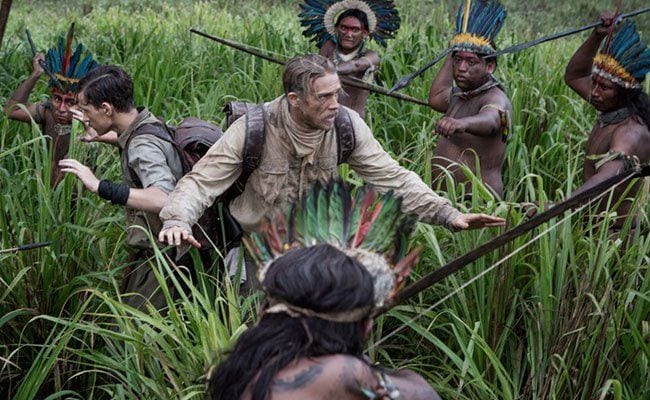
In a world that becomes smaller, more crowded by the day, it’s difficult to comprehend the thrill of genuine discovery. Most of us get excited when we find a new burger joint in our neighborhood, let alone stumble upon the relics of an abandoned civilization. It may sound like the stuff of fantasy, but that’s exactly what happened to British explorer Major Percy Fawcett during an exhibition into the uncharted Amazon.
Working from the acclaimed 2009 non-fiction book by David Grann, director James Gray sidesteps the oeuvre of Werner Herzog and forges his own sprawling jungle epic in The Lost City of Z. There’s certainly much to admire here, including stunning imagery from the beguiling jungle that eventually swallowed up Fawcett (Charlie Hunnam) and his eldest son (Tom Holland) in 1925.
What’s lacking, however, is a genuine sense of dramatic necessity. This grand adventure, rife with ambition and folly, is little more than a series of beautifully photographed scenes that never inform or build upon one another. Gray has made a film that looks expansive and engaging, but feels small and uninvolving. He fails to connect with the madness and wonder that lured Fawcett into the jungle again and again and again.
Fawcett, a man deemed “unfortunate in his choice of ancestors” by his military superiors, was doomed to lesser rank by the legacy of an alcoholic (and degenerate gambler) father. He longs for recognition and advancement, mostly to provide a better station in life for his wife Nina (Sienna Miller) and their growing family. Fawcett must accept assignments considered beneath a decorated officer, which includes traipsing around the uncharted Amazon for years at a time.
Luckily, Fawcett was one hell of an explorer. Commissioned by the Royal Geographical Society of London to map the border between Brazil and Bolivia, Fawcett and his guide Costin (Robert Pattinson) found the elusive source of the Rio Verde River in 1908. He also stumbled into a pile of priceless ruins, prompting his theory that an ancient city, cleverly dubbed ‘Z’, once existed in this sweltering hellhole.
The crux of Fawcett’s story (at least the portion we care about as a paying audience) is how he twice avoided the same fate as that of countless Conquistadors who perished while searching for the mythical jungle city of El Dorado. As it turns out, bribery and kindness go a long way. Offering trinkets and basic civility help Fawcett forge a tenuous understanding with tribal leaders, who warn his expedition away from more hostile tribes.
Sadly, the third time was definitely not the charm for Fawcett, who disappeared without a trace while searching for Z. Rather than exploiting this reality to build a sense of impending doom, director James Gray (Two Lovers 2008, The Immigrant, 2013) focuses on the man rather than the mission. In fact, the footage of Fawcett’s cruise up the Rio Verde (the Rio Don Diego in Columbia serves as a worthy cinematic substitute here) is shockingly sparse. What should be a tense journey into “the heart of darkness” settles for five minutes of spoiled white guys bickering over food followed by a fleeting arrow attack from unseen foes. The photography is admittedly beautiful, capturing the smallness of Man against the impossibly dense undergrowth and withering heat, but the jungle never becomes a character in the film.
When Herzog sent an unhinged Kinski into the jungle for the filming of Aguirre, the Wrath of God (1972), he elegantly illustrated the futility of Human ambition in the face of indifferent Nature. While we don’t expect the same madness or, as Herzog calls it, “ecstatic truth” in a mainstream film, we certainly expect to see the toll taken by such reckless hubris.
If anything, Fawcett’s journey seems too easy, with only a handful of minor inconveniences hampering his progress. At one point, he melodramatically proclaims that “The exit from Hell is always difficult!” The very next shot finds him back home in London, safe and secure. Apparently, the exit from Hell is difficult to film, as well.
Instead of focusing on Fawcett’s monumental expeditions, Gray obsesses over the minutiae of Fawcett’s personal life. It’s admirable that Gray (who also adapted the script) aspires to a more traditional epic rather than a simplistic actioner, but he fails to find the core of a story cluttered with romance, politics, warfare, sexism, racism, classism — and possibly more ‘isms’ than we’ve realized yet.
Gray would need hours to properly tackle the events and themes that inspired him to adapt Grann’s book. All he needed to do was to find the compelling story waiting for him in the Amazon. The beauty, the ugliness, the drama, the soul-crushing challenge of exploration — everything he needs to test his characters and visualize his themes — are thousands of miles removed from the stuffed-shirt hypocrisy of Fawcett’s dull world. The Lost City of Z is a rousing adventure filtered through the lens of familiar melodrama with decidedly tedious results.
This broad approach leads to some uneven cast performances. Hunnam does a lot of mumbling in the film’s opening half, before inexplicably growing a spine and challenging his racist colleagues in the second half. Miller is squandered in the ‘long-suffering wife’ role, though Nina does boldly demand to accompany Fawcett on one of his earlier jungle excursions. This flash of feminism is quickly squashed by Fawcett’s manly assertion that women are too fragile for the bush and she belongs at home raising the children. Pattinson continues to wash the Twilight stink from his resume with another solid supporting role, even if his scraggly beard and tattered hat make him look like Torgo from Manos: The Hands of Fate.
The Lost City of Z is a handsomely crafted film that might be worth seeing for the gorgeous visuals, but its story never coalesces into a singular dramatic statement. It’s the type of fictionalized biopic that never reaches the entertaining or informative heights of a good documentary.

